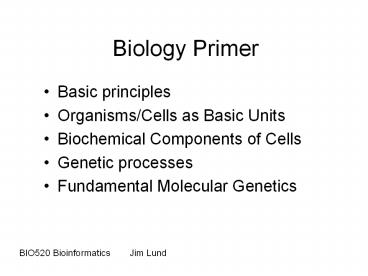Biology Primer - PowerPoint PPT Presentation
Title:
Biology Primer
Description:
Basic principles Organisms/Cells as Basic Units Biochemical Components of Cells Genetic processes Fundamental Molecular Genetics BIO520 Bioinformatics Jim Lund – PowerPoint PPT presentation
Number of Views:132
Avg rating:3.0/5.0
Title: Biology Primer
1
Biology Primer
- Basic principles
- Organisms/Cells as Basic Units
- Biochemical Components of Cells
- Genetic processes
- Fundamental Molecular Genetics
BIO520 Bioinformatics Jim Lund
2
Phylogeny
3
Prokaryotes
4
Gram-negative Prokaryotes
5
Eukaryotes
What cell compartments are present? What cell
processes are different between prokaryotes and
eukaryotes? What are protein families are unique
to eukaryotes? How is gene annotation
different?
6
Central Dogma of Molecular Biology
DNA
RNA
Protein
7
(No Transcript)
8
DNA
- G,A,T,C
- 5 to 3
- antiparallel double helix
- GC, AT
5-GATTC-3
3-CTAAG-5
9
RNA
- Single-stranded polymer
- G,A,C,U
- rRNA (90)
- tRNA (5-10)
- mRNA (1-5)
- informational
- many kinds
- snRNA, siRNA, miRNA, snoRNA
10
Other Molecules
- Lipids
- Carbohydrates
- Small molecules
- Precursors, metabolites
Proteins
11
Polypeptides
- Polymers of 20 amino acids
- amide linkages
- 100-1000 residues typical
- amino (N)-----carboxyl (C) end
- encoded by mRNAs
- modified (Pi, CH3)
Protein 1 or more polypeptide
12
Protein structure
- Primary
- AA sequence
- Secondary
- Alpha helix, Beta sheet
- Tertiary
- 3D structure
- Quaternary
- 3D structure of 2 or more protein chains bound
together.
13
JOE AVERAGE Polypeptide
- 350 amino acids
- Rare vs common aas
- Amino acids
- MW110 Da
Know your aa's
14
Protein lengths
Zhang et al., 2000
15
Protein lengths
Zhang et al., 2000
16
Proteins
- Enzymes
- Receptors
- Transporters
- Structural components
- Regulatory factors
17
Translation Reading Frames
AUGGUACCACC...
Frame 1
MetValProPro..
AUGGUACCACC...
Frame 2
TrpTyrHis....
AUGGUACCACC...
Frame 3
GlyThrThr...
18
Genetic Code
STOP
19
Long ORFs are RARE
P(ORF)(61/64)n
P(20)(61/64)20.38
P(100)0.008
P(200)10-4
20
Prokaryotic Gene Expression
Promoter
Cistron1
Cistron2
CistronN
Terminator
Transcription
RNA Polymerase
mRNA 5
3
1
2
N
N
N
C
N
C
C
1
2
3
Polypeptides
21
Eukaryotic Gene Expression
Transcribed Region
Promoter
Terminator
Enhancer
Transcription
RNA Polymerase II
Primary transcript 5
3
Intron1
Exon1
Exon2, etc
Cap Splice Cleave/Polyadenylate
Translation
7mG
An
N
C
Transport
7mG
An
Polypeptide
22
Joe Average Gene
- Encodes 350 amino acid product
- Euk
- Exons and introns, typically 5-10
- Enhancer/promoter region
- Prok 1 cistron (part of operon)
10 kbp
1.5 kbp
23
Genome elements
- Genes
- Special regions
- Origins of replication
- Telomeres
- Intergenic Regions
- Enhancers
- Chromsomal attachment sites
- Origins of replication
- Junk??
24
Genome Structure
25
E. coli genome
--------------- 10 kb
26
H. sapiens genome
----------- 50 kb
27
Genome Size and Gene Number in Prokaryotes
LINEAR
28
Genome Size and Gene Number in Eukaryotes
29
Joe Average Genome
- Human
- 3,000,000 kb
- 20,000 genes (as many as the worm C. elegans)
- 10 genes
- E. coli
- 5,000 kb
- 4,200 genes
- 90 genes!
30
Commonly used molecular biology techniques
31
DNA Cloning
32
The cloning process
- Source of Nucleic Acid
- Cloning Vector
- Host
- Selection/Screen
33
Polymerase Chain Reaction (PCR)
- Template (DNA to be amplified)
- Primer Sequences
- 18-27 base pairs (bps)
- Conditions
- Annealing temperature for primers (55-65C)
- Extension time (1-3 minutes)
- Cycles (20-35).
34
PCR
35
Sanger DNA Sequencing
36
DNA-DNA hybridization
Southern blotting
37
DNA-DNA hybridization
Dot Blot/Gene Chip
38
Transcript Analyses
- Northern Blot-1977
- Genomic transcript profiling
DeRisi, Iyer, Brown Science, 1998
Northern blot DNA microarray
39
Questions addressed by protein analysis techniques
- Identity/Amount
- modifications
- Structure
- 3D
- Detailed information about binding to ligands and
other proteins - Location
- Function
- Protein-protein interaction
- Enzymatic activity
40
Protein Expression
Western blot 2D PAGE
Charge
Size
41
Protein structure
42
Microscopy(location of a protein in a cell)
43
Investigating gene function
- Biochemistry
- Variation
- Sequence
- Expression
- Where, when, expression level?
- Knockout
- Overexpression
- Homology to well-studied proteins.
44
DNA mutation
Promoter
Transcribed Region
Terminator
Enhancer
Amount Nature
3
Intron1
Exon1
Exon2
nucleus
X
7mG
An
N
C
cytoplasm
7mG
An
45
Variation-Population
- Most variation unimportant to function
- SNPs (Single Nucleotide Polymorphism)
- Some variation has functional importance
- Eg. HBA1 mutants
- Thalassemia
- Sickle Cell Anemia
46
Phylogenetic Variation
Consensus 1 MLEARLVQASLLKKLLEAIKDLVNDANFDCSESGISLQAMDSSHVSLVSLLLRSEGFEHY 60 query 1 MFEARLVQGSILKKVLEALKDLINEACWDISSSGVNLQSMDSSHVSLVQLTLRSEGFDTY 60 1PLR 1 MLEAKFEEASLFKRIIDGFKDCVQLVNFQCKEDGIIAQAVDDSRVLLVSLEIGVEAFQEY 60 gi 400740 1 MLEAKLNNASILKKLFECIKDLVNDANVDADESGLKLQALDGNHVSLVSLHLLDSGFSHY 60 gi 129696 1 MFEAEFKTGAVLKRLVETFKDLLPHATFDCDNRGVSMQVMDTSHVALVSLQLHAEGFKKY 60
- Evolutionary changes in DNA/protein sequence.
- Variation depends on distance
- Orthologs, paralogs
- Variants function in context.
47
Induced/Directed MutationExperimental
- Often GROSS mutations
- May not reflect in any way the population or
phylogenetic variation - Critical to functional study































